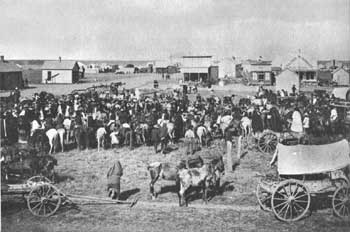






Survey of Historic Sites and Buildings
 |
GUTHRIE Oklahoma |
 |
| ||
Guthrie commemorates the first "run" of the "boomer" movement, which opened the Indian Territory to white settlers. In the 1870's settlers on the Plains began to look covetously toward the rich Indian land in what is now Oklahoma. Agitation and political pressures began about 1879 and resulted in the opening a decade later of almost 2 million acres to settlement—the Oklahoma District. The time of the run from the Kansas border was high noon, April 22, 1889, when spirited horses and steamed-up locomotives stood ready to start the rush. By nightfall settlers had claimed every parcel of land; and Guthrie, 80 miles from the starting point, was a booming tent-and-shack city of some 15,000 people. Other cities founded at the same time were Oklahoma City, Kingfisher, and Edmond.
Guthrie, established around a Santa Fe Railway depot, became a prairie metropolis overnight and soon had a chamber of commerce, three newspapers, schools, churches, hospitals, a waterworks, and electrically lighted streets. It was the capital of Oklahoma Territory, organized in 1890, and of the State from 1907 until 1910, when Oklahoma City won the honor. The modern city has few physical reminders of its "boomer" origins.
NHL Designation: 01/20/99
 |
| A group of "boomers" in El Reno, not long after Oklahoma was opened to settlement in 1889. The Oklahoma rush was the last great land rush in the United States. Courtesy, National Archives. |
 |
101 RANCH Oklahoma |
 |
| ||
This ranch was founded by George W. Miller, a trader who had left Kansas in the early 1870's with 10 tons of bacon. He arrived in Texas with enough bacon to trade for 400 Longhorns, which he herded northward to a range in Quapaw Indian Territory and later sold at a handsome profit. Leasing 60,000 acres and founding the 101 Ranch, he made arrangements with the Ponca Indians, who were living temporarily with the Quapaws, to graze his cattle on Indian land. He kept on friendly terms with the Indians and eventually bought much land from them.
At the time Miller died, in 1903, he had sown 13,000 acres of wheat on his land, planted 3,000 acres of corn, and raised 3,000 acres of forage crops. His income ranged from $400,000 to $500,000 a year, and just before his death oil was found on his land. In 1908, the Miller Brothers 101 Ranch Wild West show, under the management of Miller's three sons, gave its first appearance at Ponca City. Devoting all their time to the show, which traveled around the country and featured such film cowboy stars as Tom Mix and Buck Jones, the brothers neglected the ranch. Between 1921 and 1931, oil prices fell, the show failed, and two of the brothers died. The third was unable to manage the ranch, which passed into receivership and was sold in parcels to subsistence farmers.
The most impressive remain is the White House, a three-story home Miller was building at the time of his death. Before that time the ranch headquarters was a dugout. Two miles west of the ranch is White Eagle Monument, erected by the Miller brothers in memory of the Ponca Indian chief who had dealings with their father.
 |
 |
http://www.cr.nps.gov/history/online_books/prospector-cowhand-sodbuster/sited11.htm
Last Updated: 22-May-2005